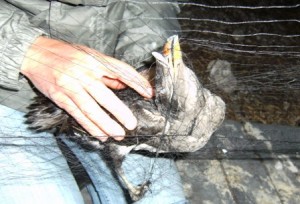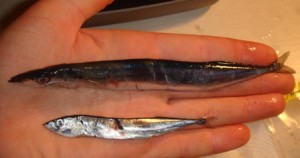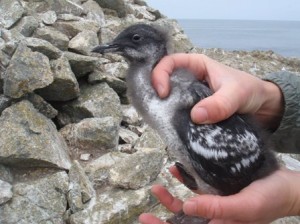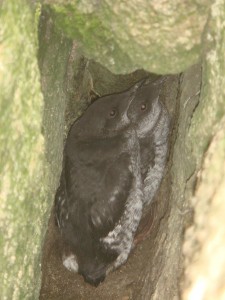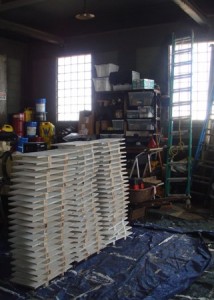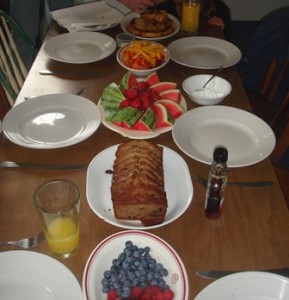Well, my last boat day has officially come and gone, and with it my roommate Jordan. It’s a really weird thought to think that the next boat that lands here will be taking me away! However, the season is definitely starting to slow down. Murre work is completely finished, and we’ve started officially calculating their productivity this year, a depressing task. Across the island, productivity will be near zero, the worst ever seen in a non-el Nino year (during el Nino, murre productivity often averages around 0.2).
Western Gulls, whose chicks are growing up very fast, are also winding down. We’ve officially stopped monitoring nests that failed (whose chicks or eggs disappeared), and are now only working to re-sight chicks we banded this year, confirming via their unique metal band number that they are still alive, and recording the chicks’ feathering status.
Cassin’s Auklets, this year’s greatest success story, are also, at least for me, nearing an end. I am down to only two chicks left on my daily chick checks, the rest have fledged. Many of the nest boxes DO contain birds who are currently sitting on their second egg, but they are on what we call a “skip period,” where we don’t disturb them for a couple of weeks. By the time the eggs hatch, or come off of skip, I will probably have left the island.
Rhinocerous Auklets and Pigeon Guillemot work, however, is still going strong. Pigeon Guillemot diet watch continues to happen every three days, and because of recent foggy weather, we haven’t been able to do diet watch at one of our sites in almost 10 days. To compensate for this, we are now going on “standby,” meaning that any day that isn’t foggy will automatically become a PIGU diet watch day, so that we can catch up on lost data from the site on Lighthouse Hill.
Rhino diet is still being monitored as well–we just finished up our third round of Rhino netting, and aside from an extremely hard bite on my finger, everything went really smoothly. Although the Rhino in this picture may look incredibly tangled, seabirds this large are, for the most part, really easy to remove from the net. The largest complication with rhinos stems from the fact that they have a very long tongue, and twice now, I’ve seen the net actually wrap around their tongues. Removing birds who have been caught in this way can be VERY difficult, since you can actually rip their tongue out if their are removed incorrectly, and you still have to be wary around their really strong bills.
The diet of the Rhinos has also changed noticably as of late. Whereas our first round of netting produced an abundance of Greenling, the last two rounds have seen diets of around 90% Pacific Saury. As you can see in the picture, Saury vary greatly in size, weighing anywhere from just a few grams up to almost thirty. We’ve also seen a lot of squid, and a few Myctophids, the deep sea fish, which are most often California Headlightfish or Blue Lanternfish.
My Pigeon Guillemot Breed study continues to take up at least a few hours every five days, and these chicks are really growing! As I mentioned, they are often born in clutches of two, and unfortunately, very few Chick #2’s remain, most having been killed by their sibling or simply starved. The chicks that are left, however, are growing very quickly, and we’ve even already seen our first fledge. Believe it or not, the chick in this photo is the same chick that I pictured earlier in the season, although then he looked only like a tiny black puffball. These chicks now weigh almost 400 grams, and so we’ve started banding them and checking their attendance daily, to monitor fledge dates.
Here is actually a picture of one of my only sites that still has two chicks in it. As they get bigger and bigger, they look more and more uncomfortable wedged into their tiny crevices. Every five days, I have to pull them out and weigh them, and it’s actually getting pretty difficult, since it’s hard to wrap my hand around them, and often hard to remove them from their wedged positions.
Finally, with the slowing down of the bird work, we’ve all had a chance to get some other types of work done. A lot of maintenance goes in to keeping all of these buildings running, as well as maintaining all of the study boxes and plots, so over the last few days, I’ve been working on Cassin’s Auklet Box Shades. These shades keep our Auklet boxes close to the temperature of a natural burrow, but only a few wooden ones are currently in use. The rest of them are built out of foam, which is really starting to disitengrate, making it difficult to identify which box you’re working at, but also spreading bits of foam all over the island. To remedy this, we’re working on constructing enough wooden shades to replace all the foam ones. Last week, Jordan and Meghan cut the wood for 64 new shades, and over the last few days, Hannah and I have nailed them all together and painted them white. It’s taken up quite a bit of time actually, and hopefully in the next couple of days we’ll get them distributed across the island.
To end with, I thought I’d include a picture of yesterday’s brunch, which was the best one yet, thanks to the abundance of fresh fruit. On the menu were watermelon, strawberries, blueberries, raspberries, nectarines, mango, chocolate chip banana bread, french toast, scrambled eggs, and (for everyone else) bacon. It’s always nice to have such fresh fruit available, since it doesn’t last for long!
Well, that’s all for now!
Best,
Eleanor

